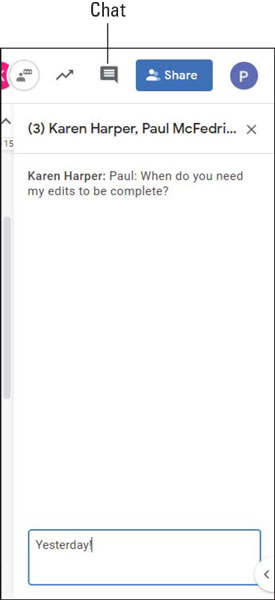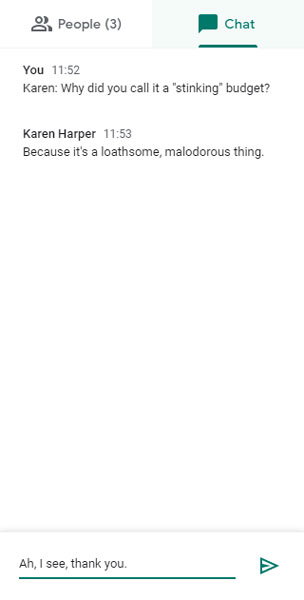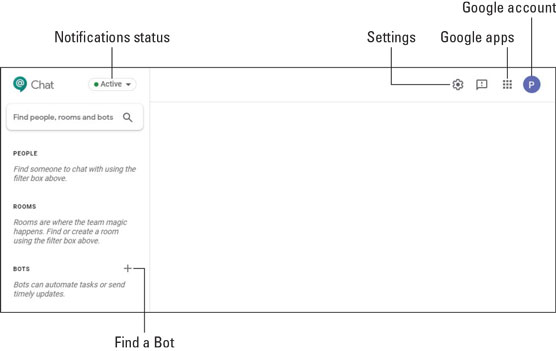As proof of chat's ascendance in the corporate communications realm, you need look no further than the myriad ways that G Suite enables its users to message each other: Gmail, Docs, Sheets, Slides, and Meet. Before moving on to Google Chat, the next few sections take a quick look at these alternative chat methods.
 In a shared Docs, Sheets, or Slides file, click the Chat icon to converse with your collaborators.
In a shared Docs, Sheets, or Slides file, click the Chat icon to converse with your collaborators.
 In a Meet video conference, click the Chat icon to message the meeting participants.
In a Meet video conference, click the Chat icon to message the meeting participants.
 Google Chat's web home.
Google Chat's web home.
Chatting with Gmail
When you're hanging around in Gmail, you can use Google Hangouts to exchange messages with people you know, including people outside of your organization. You can set up a classic one-on-one text conversation, or you can organize (or join) a group chat of up to 100 people.Here are the steps to follow in order to start a chat in Gmail:
- In the Chat section of the navigation menu running down the left side of the page, click the New Conversation (+) icon. A Hangouts Chat dialog box appears, prompting you to specify someone to chat with.
- (Optional) If you want to chat with two or more people, click New Group and then use the Name Your Group text box to enter an optional moniker for the group.
- Use the Enter Name, Email Address, or Telephone Number text box to enter the name, email, or phone number of the person you want to chat with. Hangouts Chat displays a list of names that match what you've typed so far in three categories: people inside your organization; people outside your organization who have a Hangouts account; and people who don't have a Hangouts account.
If you see the person you want, select that name from the list.
 As you enter a name or an address, you see a list of names that match.
As you enter a name or an address, you see a list of names that match. - If you opted to chat with a group, repeat Step 3 as needed to populate the group. When you're done, select the check mark. Hangouts Chat opens a chat window.
- For a one-on-one conversation, click Send Invitation; for a group chat, send your initial message. Hangouts Chat sends the invitation or message, which appears in the other person's (or persons') Chat area in Gmail. When that person clicks (or those people click) Accept, you can begin the conversation.
Chatting with Docs, Sheets, and Slides
When sharing a document, spreadsheet, or presentation with other people, you might need to ask a question or just be sociable with someone who's editing the file with you. Easier done than said: Click the Chat icon in the top left corner of the screen to open the Chat pane and then start "talking." In a shared Docs, Sheets, or Slides file, click the Chat icon to converse with your collaborators.
In a shared Docs, Sheets, or Slides file, click the Chat icon to converse with your collaborators.Chatting with Meet
During a meeting, you might want to make a comment to another participant without interrupting the meeting, ask a question, or share a link with everyone. You can do all that and more by clicking the Chat icon to open the Chat pane, as shown.Remember that all Meet chats are public, meaning that anyone else in the meeting can read the messages you exchange with someone. Therefore, Meet chats are definitely not the place to rag on your boss or make snarky comments about someone in the meeting!
 In a Meet video conference, click the Chat icon to message the meeting participants.
In a Meet video conference, click the Chat icon to message the meeting participants.Chatting with Google Chat
The rest of this chapter covers Google Chat, which is the main messaging app for G Suite users. To get you started, here are the three ways you can access Google Chat (which I call Chat from here on out):- On the web: Take your web browser by the hand and guide it gently to Google Chat. The figure shows the stark Chat landscape that appears when you first open the site.
 Google Chat's web home.
Google Chat's web home.If you've been conducting some Hangouts Chat conversations recently, they'll likely show up here, so your version of the Chat page might look a little livelier.
- On the desktop: There's a Chat app available for Windows and Mac. Click the Download button.
- On your mobile device: There's a mobile version of the Chat app available for Android and iOS. Use Google Play (Android) or the App Store (iOS) to install the app on your device.





